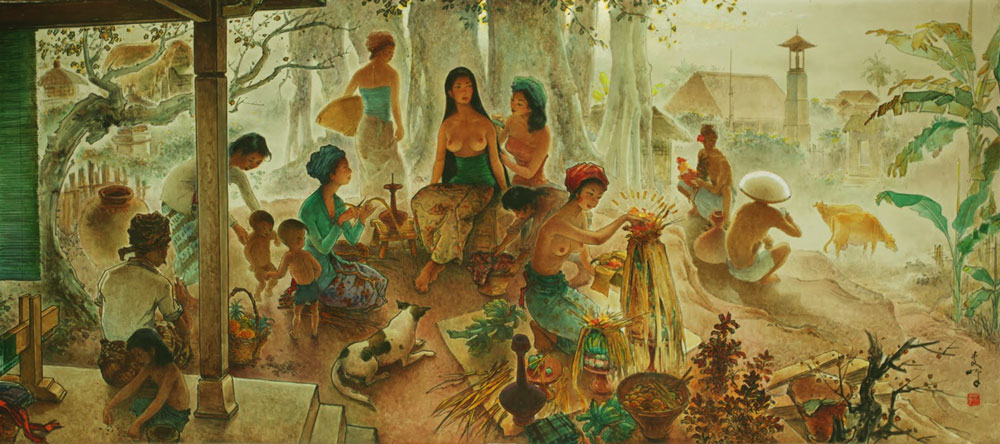|
(b. 1913,
Guangdong,
China–d. 1988, Jakarta, Indonesia) was a prominent artist based in Indonesia
and Singapore. Primarily working with oil paintings, Lee was associated with
the Nanyang style, which blends Chinese techniques and subjects with Western
composition styles and mediums.
Early life
and education
Born in Guangdong in 1913,
Lee was three years old when his family emigrated to Singapore. His father,
Lee Lingxi, managed a shop selling Western-style clothes and Chinese furniture
on High Street.
Lee was educated at
Yangzheng
School
and St Andrew’s School. At the former, he was taught to sketch life forms
by Mei Yutian, a master in the Lingnan style of Chinese brush painting. From
the age of 16, Lee learnt the techniques of oil painting from Huang Qingquan.
His first oil painting, The Shuanglin Temple (1929), demonstrated an early
aptitude for perspective and composition.
Move to Indonesia and career
After his father died
in 1930, Lee drew cartoons for newspapers and worked for advertising agencies,
where he painted lacquer billboards and designed advertisements.
In 1932, he moved to
Jakarta
to become the art editor of a Chinese paper, Shibao, which he left the following
year to become a designer at established publishing firm Koiff and Company.
Lee left the company in 1936 and set up an advertising agency, Linto Reclame
Bureau, with friends.
In August 1937, Lee met
Lie Muk-Lan, a music graduate of Shanghai’s prestigious College of Arts in
Jakarta. They married in January 1938 under the auspices of the Chinese Consul-General
in Singapore before returning to Jakarta. Their son Lee Rern was born in 1938
and daughter Lee Ie-Ling in October 1941.

Artistic career
Even as he established
his name in advertising, Lee never gave up on his artistic pursuits. In 1936,
he exhibited his paintings for the first time at an exhibition organised by
the Dutch Indies Art Association. When Dutch governor-general B. C. de Jong
purchased Lee’s Telaga Warna, or Coloured Lake, the previously unknown Chinese
artist’s name was put on the radar of art circles in Indonesia and Holland.
In 1941, Lee left the
world of advertising to become a full-time artist. He spent three months painting
in Bali
and organised his first solo exhibition in Jakarta before travelling to Singapore
to meet acclaimed Chinese artist Xu Beihong.
During the Japanese Occupation
of the Dutch East
Indies, Lee was
arrested and imprisoned by the Japanese military government because of his
involvement with the underground revolutionary Fu Xing She (meaning "Restoration
Society" in Chinese). His prison jailer, Takahashi Masao, had studied art
and befriended Lee. Takahashi secretly smuggled brush and paper for Lee and
even attempted to obtain an early release for the young artist but to no avail.
Lee was eventually released after six months as he had not committed any crime
against the Japanese.
During the Occupation,
Lee also befriended Sukarno, a young Indonesian officer who later became independent
Indonesia’s first president. According to Lee, Sukarno often drove him to
art galleries, where they would discuss the works on display.
Time in Holland
After the end of the Japanese
Occupation, Lee was commissioned by Dutch viceroy Hubertus van Mook to paint
a portrait of his wife. Impressed by the resulting portrait, van Mook personally
recommended Lee for a Malino scholarship to Holland despite his mature age
of 34, his lack of formal art training and his status as a foreign immigrant
of neither Dutch nor native Indonesian descent. Accompanied by his wife,
Lee spent six years in the
Netherlands,
though his scholarship only covered three years of his stay there. Between
1946 and 1952, Lee held four solo exhibitions in
Amsterdam
and The Hague, and participated in an international Salon (art exhibition)
in Paris.
Lee’s study of the original
works of European masters such as Rembrandt van Rijn and Vincent van Gogh
was reflected in his works of the period, such as Man with a Pipe (1949) and
The Ballerina (1950), which featured dramatically spot-lit subjects, vigorous
brushwork and rich colours.
Return to Southeast Asia
When Lee returned to
Indonesia
in 1952, his artistic technique had reached a level of maturity hitherto unseen.
He largely produced works of Indonesian subjects such as The Balinese Youth
(1952) and The Rojak Seller (1953), perhaps reflecting his subconscious longing
for these familiar subjects after a six-year separation.
In 1961, Lee became art
consultant to the Indonesian presidential palace and chief curator of its
collection, positions facilitated by his experience and friendship with President
Sukarno. From 1962 to 1964, Lee restored and catalogued the presidential and
the state collections, an extensive endeavor that culminated in a five-volume
book collection.
Lee returned to
Singapore
in 1967 at the request of his aged mother and made
Singapore
his home base for the next 20 years. While in
Singapore,
Lee held two high-profile solo exhibitions at the Victoria Memorial Hall in
1967 and in 1981.
In 1987, Lee held his
final solo exhibition in Singapore at the National Museum Art Gallery and
donated proceeds from the sales of his paintings, prints and catalogues to
the National Kidney Foundation.
|